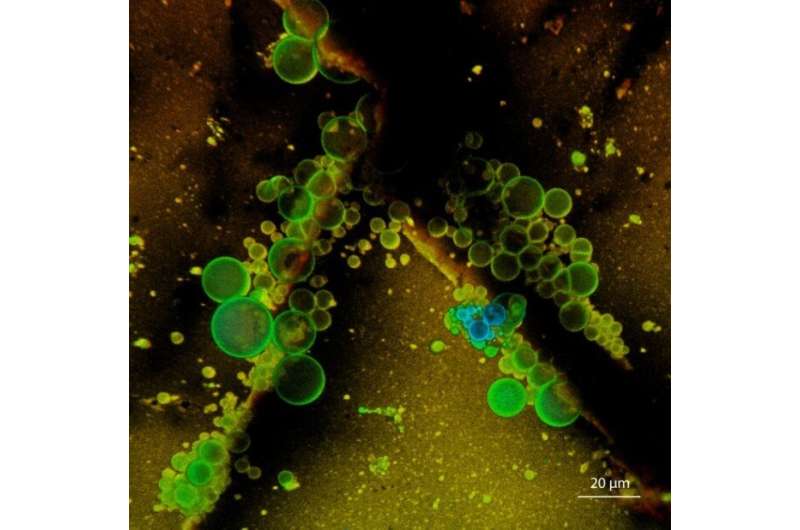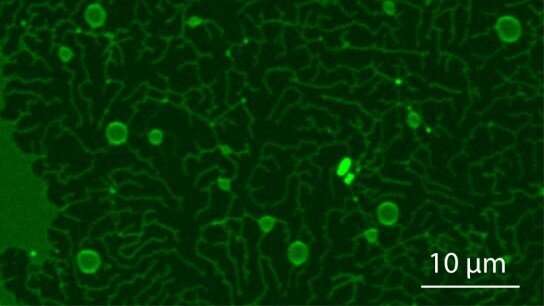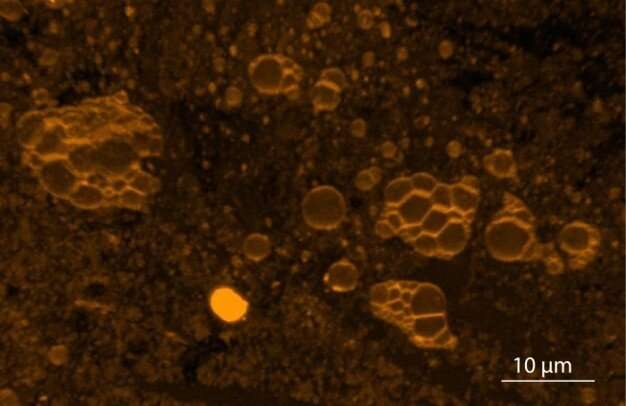Autonomous formation of primitive cells observed on ancient Earth surfaces and on a specimen from Mars

New research by the University of Oslo provides experimental evidence that populations of ancient primitive cells could have autonomously assembled on minerals under early Earth conditions, and on the ancient crust of Mars.
Today’s laboratory models of the most primitive ancient cells, often referred to as ‘protocells’ which could have initiated the development of life approximately 4 billion years ago, typically consist of soft spherical lipid capsules freely suspended in water. These models well explain initial, but not subsequent steps in the development towards substructured protocells, such as the formation of inner compartments, or possible sharing of internal components among different individual units.
In a recently accepted article in the journal ChemSystemsChem, a team of researchers from the University of Oslo, University of Colorado and University of Copenhagen, show the autonomous development of prebiotic compartments on thin sections of natural surfaces, one of them obtained from the martian meteorite NWA 7533 “Black beauty.”
For their experiments, the researchers brought small unordered lipid droplets suspended in water in contact with natural surfaces, and observed the interactions under a high resolution light microscope. Lipids are thought to be among the earliest organic molecules on the early Earth.

They observed the spontaneous formation of extraordinary protocell morphologies on the natural surfaces, predominantly dense agglomerates of primitive cells, including protocell networks interconnected by nano-size tubular ‘highways’. The protocell populations were shown to grow mostly at the fractures of the investigated natural surfaces, and remain there intact for several days.
The researchers have earlier discovered that the intrinsic energy of naturally occurring surfaces, which were abundant on the early Earth, could have been utilized by lipid reservoirs to autonomously transform to primitive membrane shells of molecular thickness. Since biochemical fuel molecules used by modern cells today most likely did not exist on the early Earth, this source of energy, which is large enough to cause simple molecular rearrangements, might have had a critical role in the formation of robust surface-bound protocell communities. Such populations of interconnected individual protocells can easily transfer internalized constituents, thus communicate chemically, and also better resist harsh environmental conditions.
Similar results observed on a Martian meteorite sample, which represents a very early period in the development of the red planet where water was most likely present, provides evidence that self-formation of primitive cells on Mars is also a distinct possibility, and can perhaps complement the anticipated findings of the robotic missions by Perseverance and Ingenuity.

The pre-biotic bubbles which are sticking on the solid supports can open small pores for very short times and take in the genetic polymer RNA through the pores. RNA can self-replicate and is hypothesized to exist at the origin of life before DNA and proteins.
The researchers’ findings support the ‘Lipid World’, a hypothetical stage in early evolution during which lipids played multiple key roles simultaneously, including compartment formation, collective self-reproduction and compositional inheritance.
The formation of protocell populations on natural surfaces could have been the starting point of a feasible route towards the transformation from non-living to living entities.
Scientists discover how surfaces may have helped early life on Earth begin
Elif Köksal et al, Spontaneous formation of prebiotic compartment colonies on Hadean Earth and pre‐Noachian Mars, ChemSystemsChem (2021). DOI: 10.1002/syst.202100040
Citation:
Autonomous formation of primitive cells observed on ancient Earth surfaces and on a specimen from Mars (2022, February 3)
retrieved 3 February 2022
from https://phys.org/news/2022-02-autonomous-formation-primitive-cells-ancient.html
This document is subject to copyright. Apart from any fair dealing for the purpose of private study or research, no
part may be reproduced without the written permission. The content is provided for information purposes only.
For all the latest Science News Click Here
For the latest news and updates, follow us on Google News.

